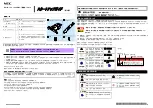
Quatech USB-to-Serial Adapter User’s Manual
Introduction
Introduction
This User’s Manual describes how to setup and install your Quatech
USB-to-Serial Adapter.
The Quatech SSU2-100, DSU2-100, QSU2-100 and ESU2-100,
respectively, provide one, two, four and eight independent RS-232
serial interfaces to the host PC via the Universal Serial Bus (USB)
port.
Note: These products comply
fully with USB Specification
version 2.0. They will also
operate over slower USB 1.1
connections at a slightly
reduced performance level.
The Quatech DSU2-400, QSU2-400 and ESU2-400, respectively,
provide two, four and eight independent asynchronous serial
interfaces via the USB port. Each of these interfaces can be used as
desired for RS-232, RS-422 or RS-485 communications.
Table 1 - Device port and connection options
Device
Ports Connection
Device
Ports Connection
SSU2-100 1
RS-232
DSU2-100 2 RS-232 DSU2-400
2 RS-232/422/485
QSU2-100 4 RS-232 QSU2-400
4 RS-232/422/485
ESU2-100 8
RS-232 ESU2-400
8 RS-232/422/485
Note: The “-400” designation
indicates an “MEI” device.
MEI is an acronym for
“Multiple Electrical Interface.”
The interface is software-
selectable for each serial port.
Each adapter uses high-speed UARTs and deep FIFOs, allowing each
channel to obtain data rates up to 921.6 kbps. The adapters are
powered over their USB connection (bus-powered), eliminating the
need for an external power supply. The adapters are Plug-and-Play
devices and require no hardware configuration.
System requirements
Quatech’s USB-to-Serial adapters are supported under the Windows
2000/XP (and later) and Linux operating systems. One USB port is
required to connect the adapter to your computer. You can use either
a built-in USB port or an add-in USB host adapter. We recommend
the use of a USB 2.0 port for best performance. Contact our sales
department for details on current software offerings. All device
drivers are available for download from the Quatech World Wide Web
site at
http://www.quatech.com/
.
Rev 1.01 (February 2007)
Page 1






































